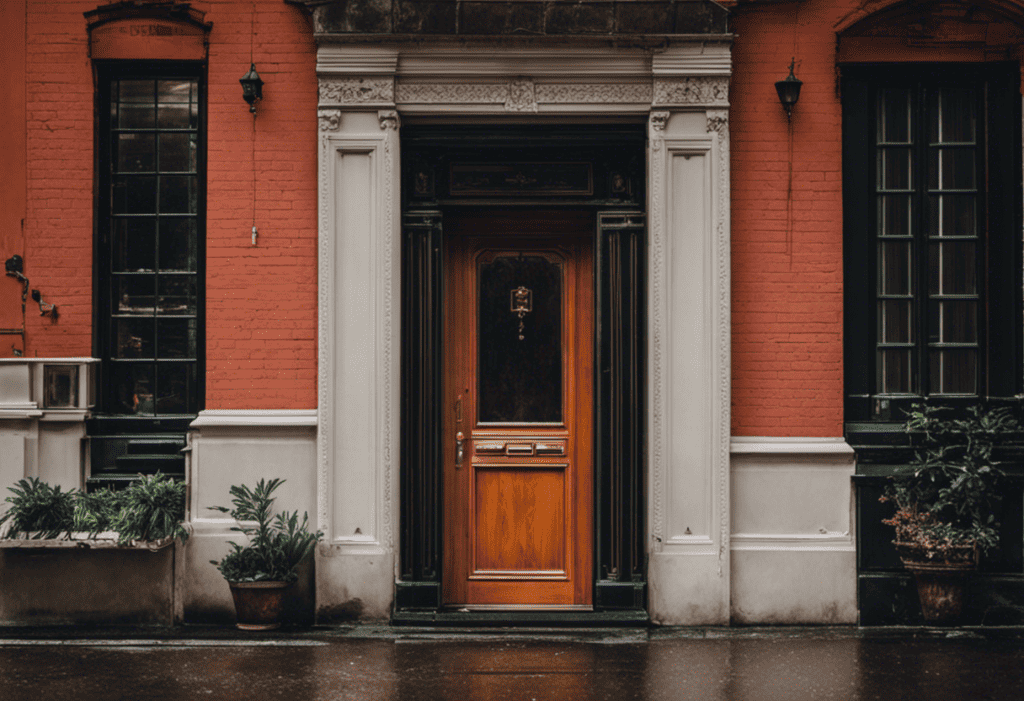
Image that showcases a well-sealed door frame with a sturdy, weatherproof strip installed at the top
I’ve dealt with the frustrating issue of water coming in through the top of the door frame. It can cause severe damage and needs immediate attention.
My firsthand experience and offer practical solutions in this article. Insufficient caulking, incorrect installation, and damaged materials are common culprits.
I’ll discuss inspecting and re-caulking the frame, checking for proper flashing, and repairing any cracks. Plus, I’ll cover preventive measures like high-quality caulking and weatherstripping.
By following these steps, you can protect your home from water intrusion.
Key Takeaways
- Inspect and re-caulk around the entire door frame with high-quality, exterior-grade caulking
- Check for proper flashing around the door and repair/replace as needed
- Inspect the door frame itself for any cracks, rotting, warping and repair or replace as needed
- Install or replace weatherstripping around the door
Causes of Water Intrusion Through Door Frames
I will now discuss the causes of water intrusion through door frames.
Failing caulking and weatherstripping can create gaps that allow water to enter. Issues with installation and flashing can also lead to water infiltration.
Additionally, deterioration of the door frame and problems with the roofing, siding, and gutters above the door can contribute to water intrusion.
Failing Caulking and Weatherstripping
Failing caulking and weatherstripping can be significant causes of water intrusion through door frames. When the caulking around the door frame deteriorates or becomes damaged, it loses its ability to create a watertight seal. Similarly, water can seep through gaps if the weatherstripping isn’t correctly installed or worn out.
To address these issues, evaluate the performance of the caulking and troubleshoot any weatherstripping problems. One way to evaluate caulking performance is by checking for cracks, gaps, or signs of deterioration. If any issues are found, re-caulking with high-quality exterior-grade caulking is recommended.
When troubleshooting weatherstripping, ensure it’s properly installed and replace it if necessary. Additionally, improving door frame insulation can help prevent water intrusion by reducing gaps and improving the seal.
Regular door frame maintenance and inspection, including checking for cracks, rotting, or warping, is also essential in preventing water intrusion.
Flashing and Installation Issues
Improper flashing or installation can lead to water intrusion through door frames. Evaluating the flashing and installation is crucial to identify and address any issues causing water to enter through the top of the door frame.
Here are three key areas to consider when evaluating flashing and installation issues:
- Flashing Inspection:
- Check for proper installation of flashing around the door frame.
- Look for gaps or damage in the flashing that may allow water to seep in.
- Ensure that the flashing is securely attached to the surrounding materials.
- Drainage Improvement:
- Assess the drainage system above the door, such as the roof and gutters, to identify any blockages or damage contributing to water intrusion.
- Clear clogged gutters and downspouts to ensure proper water flow away from the door frame.
- Consider installing additional drainage solutions, such as drip edge or gutter extensions, to redirect water away from the door.
- Professional Assistance:
- If you’re unsure about evaluating flashing or improving drainage, it may be best to call professionals specialising in door installation and waterproofing.
- Experts can accurately assess the situation, provide expert advice, and perform necessary repairs or replacements to prevent further water intrusion.
Deterioration of the Door Frame Itself
When inspecting for causes of water intrusion through door frames, deterioration of the door frame and how it may contribute to the problem, evaluating the deterioration of the door frame is crucial in identifying the root cause.
One common issue is rotting wood, which can create gaps for water to seep through. To address this, it’s necessary to repair rotting sections of the door frame or replace it entirely if the damage is extensive.
Additionally, warping of the door frame can also contribute to water intrusion. To prevent warping, it’s essential to ensure proper installation and maintenance of the door frame. Regular inspections and repairs are necessary to maintain the integrity of the door frame and prevent water intrusion.
Roofing, Siding, and Gutter Problems Above the Door
I can identify roofing, siding, and gutter problems as causes of water intrusion through door frames. When evaluating the drainage system, there are several potential issues to consider:
Roofing Problems:
- Inspect the roof for any damage, such as missing shingles or cracks.
- Repair roof damage promptly to prevent water from seeping into the door frame.
- Consider hiring a professional to ensure the repair is done correctly.
Siding Problems:
- Examine the siding above the door for any cracks or gaps.
- Repair or replace damaged siding to prevent water from entering the door frame.
- Use high-quality exterior caulking to seal any gaps effectively.
Gutter Problems:
- Assess the functionality of the gutters above the door.
- Clean out any debris or clogs that may be obstructing proper water flow.
- Consider installing gutter guards to prevent future clogs and improve gutter functionality.
Solutions to Stop and Prevent Leaks
To stop the water intrusion immediately, I recommend plugging the leak temporarily with caulking or rags and placing a tarp or bucket inside to catch water.
Turning off any water sources is essential to rule out other causes.
To prevent future leaks, ensure proper door installation and flashing, use high-quality exterior caulking and weatherstripping, and regularly inspect and maintain all materials.
Additionally, consider installing protective elements like awnings above doors and ensuring proper drainage and runoff away from the door.
Immediate Steps to Stop Intrusion
One immediate step to stop water intrusion is to use caulking, rags, or other materials to plug the leak temporarily. This will help prevent further water from entering the door frame and causing damage.
However, it’s important to note that these temporary fixes should only be used as a short-term solution, as they aren’t as effective or long-lasting as proper sealing. Evaluating temporary fixes is crucial to address the immediate issue, but it’s also necessary to prioritize the importance of proper sealing.
If left unaddressed, water intrusion can lead to potential damage, such as rotting wood, warped frames, and other structural issues. Therefore, taking immediate action and proceeding with more permanent solutions is essential to prevent further water intrusion.
Inspecting and Repairing Caulking and Weatherstripping
First, thoroughly inspect the caulking and weatherstripping around the door frame to identify any areas of damage or wear. This is an important step in evaluating the effectiveness of the caulking and finding any gaps in the weatherstripping that may be allowing water intrusion. Use a flashlight to carefully examine the entire perimeter of the door frame, paying close attention to the top where water may be entering. Look for cracks, gaps, or signs of deterioration in the caulking or weatherstripping.
To make it easier for you to understand the inspection process, here is a table summarizing the key areas to check:
| Area to Check | Signs of Damage or Wear |
|---|---|
| Caulking around the door frame | Cracks, gaps, peeling |
| Weatherstripping | Tears, gaps, fraying |
| Door frame materials | Rotting, warping |
| Installation of flashing | Improper or damaged |
| Roof, siding, gutters above door | Damage, clogs |
Once you have identified any areas that need repair, take action to prevent further water intrusion. Repair any damaged caulking by removing the old caulking and applying a new bead of exterior-grade caulking. Replace torn or worn weatherstripping, ensuring a tight seal around the door. Addressing these issues can effectively prevent water from entering through the top of the door frame.
Evaluating and Replacing Flashing
I will evaluate the condition of the flashing and replace it if necessary to effectively stop and prevent leaks. When evaluating the flashing, I’ll follow these steps:
- Inspect the flashing for any signs of damage, such as cracks, gaps, or deterioration.
- Check the flashing installation to ensure it’s properly aligned and securely attached to the door frame.
- Assess the effectiveness of the flashing in diverting water away from the door frame.
I’ll replace the flashing if any issues are identified during the evaluation. Here are the steps to replace the flashing:
- Remove the old flashing carefully, not damaging the door frame or surrounding materials.
- Clean the area thoroughly to ensure proper adhesion of the new flashing.
- Install the new flashing, ensuring it’s aligned correctly and tightly secured to the door frame.
Fixing Damage to the Door Frame
When fixing damage to the door frame to stop and prevent leaks, assess the extent of the damage and determine the appropriate solutions. Start by thoroughly inspecting the door frame for any cracks, rotting, warping, or other signs of deterioration.
Once the damage has been assessed, you can proceed with the necessary repairs. Depending on the severity of the damage, repairing techniques may include filling cracks with wood filler, replacing damaged sections of the frame, or reinforcing weak areas with additional support. It’s crucial to use high-quality materials and techniques to ensure long-lasting repairs.
Consider installing weatherstripping and a door sweep to prevent further water intrusion. By accurately assessing the damage and determining the repairs needed, you can effectively fix the damage to the door frame and prevent future leaks.
Improving Drainage and Runoff
I’ll improve drainage and runoff around the door to prevent future leaks. Here are some recommended solutions:
- Grading and Landscaping:
- Ensure that the ground slopes away from the door to divert water flow.
- Consider installing a French drain or gravel trench to help drain excess water.
- Use landscaping techniques such as installing retaining walls or creating swales to redirect water away from the door.
- Gutter Maintenance:
- Regularly clean and inspect gutters to prevent clogs and blockages.
- Repair or replace any damaged or leaking gutters.
- Install gutter guards to prevent debris from entering and clogging the gutters.
- Roof Repair and Maintenance:
- Inspect the roof regularly for any signs of damage or deterioration.
- Repair or replace any damaged or missing shingles.
- Ensure flashing around the roof is installed and sealed to prevent water intrusion.
Adding Protective Elements
One of the most effective ways to prevent water leaks is by adding protective elements to the door frame. These elements can provide an extra layer of defence against water intrusion and help to keep your door frame dry. Several options exist for adding protective elements depending on your specific needs and preferences.
Firstly, you can consider improving landscaping around the door. Ensuring that the ground slopes away from the door prevents water from pooling near the frame and potentially causing leaks. Additionally, adding plants or hardscapes that redirect water away from the door can further enhance the protection.
When immediate action is required, temporary leak solutions can be employed. This may involve using caulking, rags, or other materials to plug the leak temporarily until a more permanent solution can be implemented.
For more complex issues or unsure about the best course of action, it’s advisable to seek professional assistance. A professional can accurately assess the problem and provide expert guidance on the most appropriate protective elements to add to your door frame.
When to Call a Professional
If I notice persistent water leaks despite attempting the recommended solutions, it may be time to call a professional for further assistance. Here are some signs that indicate it’s time to seek professional help:
- Evaluating door installation:
- A professional can assess the installation of the door and determine if any errors were made that are causing the water leaks.
- They can identify gaps or improper sealing around the door frame that may allow water intrusion.
- Identifying roof damage:
- A professional can inspect the roof above the door and identify any damage or issues contributing to the water leaks.
- They can determine if missing shingles, damaged flashing, or other roof problems must be addressed.
- Maintaining gutters/drainage:
- Professionals can evaluate the condition of the gutters and drainage systems above the door.
- They can clear clogs, repair damage, and ensure proper water flow away from the door to prevent further leaks.
Calling a professional can thoroughly assess the situation and ensure that all underlying issues contributing to the water leaks are addressed.
Preventing Future Leaks
To prevent future leaks, focus on proper installation and flashing, regular maintenance and inspection, using high-quality materials, and implementing protective measures.
Ensuring the door is installed correctly and flashed will help create a tight seal and prevent water intrusion.
Regular maintenance and inspection of the door frame, caulking, and weatherstripping will help identify and address any issues before they become significant problems.
Using high-quality exterior caulking and weatherstripping will provide a durable barrier against water.
Additionally, installing protective elements like awnings above doors and sloping the ground away from the door can prevent water from entering through the top of the door frame.
Installation and Flashing
To prevent future leaks, I recommend ensuring proper installation and flashing of the door. Here are some steps to take:
- Evaluate the installation: Check if the door was installed correctly. Look for gaps or inconsistencies in the frame and make necessary adjustments.
- Improve drainage: Ensure the flashing around the door is installed correctly and functioning. This will help redirect water away from the door and prevent it from seeping in. Consider installing a drip cap or adding a sloping threshold to enhance drainage.
- Seek professional assistance: If you’re unsure about the installation or flashing, it’s best to consult a professional. They can evaluate the current setup, identify issues, and provide expert guidance on preventing future leaks.
Maintenance and Inspection
Regularly maintaining and inspecting the door frame is essential for preventing future leaks. By regularly checking the seals, caulking, and weatherstripping, you can identify any signs of wear or damage early on and take appropriate action.
Inspections are recommended at least once a year and more frequently in areas with extreme weather conditions. DIY repairs can be done if minor issues are detected, such as re-caulking or replacing weatherstripping. However, it’s advisable to seek professional assistance for more complex problems or if you’re unsure how to fix the case.
Professionals have the expertise and tools to diagnose and repair any underlying problems accurately, ensuring long-term effectiveness and preventing further water intrusion.
Using Quality Materials
Using high-quality materials is essential in preventing future leaks in the door frame. By evaluating the installation, maintaining materials, and improving drainage, you can ensure a watertight door frame that will withstand the elements. Here are some key steps to take:
- Evaluate Installation:
- Ensure proper door installation and flashing
- Check for any cracks, rotting, or warping in the door frame and repair or replace as needed
- Install or replace weatherstripping around the door
- Maintain Materials:
- Use high-quality exterior caulking and weatherstripping
- Regularly inspect and maintain all materials, such as caulking and sealants, to prevent deterioration
- Consider adding an awning above the door for additional protection
- Improve Drainage:
- Inspect and repair any roof, siding, or gutter damage above the door
- Slope ground and hardscapes away from the door to redirect water flow
Protective Measures
Fortunately, I can prevent future leaks by inspecting and maintaining the materials regularly. To evaluate the door installation, I should check for proper flashing and repair or replace it as needed. Use high-quality exterior caulking and weatherstripping to ensure a tight seal. Regularly inspecting the door frame for cracks, rotting, or warping is crucial, as any damage should be repaired or replaced promptly.
Improving drainage is also vital in preventing water intrusion. As needed, I should inspect and repair the roof, siding, and gutters above the door. Additionally, installing an awning above the door can provide further protection.
I should call a professional for assistance if I’m unsure about these tasks. I can minimize the risk of future leaks by implementing these protective measures.
Frequently Asked Questions
Can I Use Regular Caulking to Seal the Door Frame, or Do I Need a Specific Type of Caulking?
I’d recommend using high-quality exterior-grade caulking for sealing the door frame. Regular caulking may not provide the same level of waterproofing and durability. Consider using specific types of caulking for better results.
How Do I Know if the Flashing Around the Door Needs to be Repaired or Replaced?
To determine if the flashing around the door needs repair or replacement, inspect it for signs of damage, such as cracks, gaps, or deterioration. If any issues are found, consult a professional for flashing repair or replacement to ensure proper door frame maintenance.
Can I Repair a Cracked or Rotting Door Frame, or Do I Need to Replace It Entirely?
I recommend assessing the door frame’s damage before deciding whether to repair or replace it. Depending on the severity of cracks or rot, it may be possible to repair, but replacement may be necessary for extensive damage. Proper sealing techniques and regular maintenance can help prevent future issues.
What Is the Purpose of Weatherstripping and How Does It Help Prevent Water Intrusion?
Weatherstripping prevents water intrusion by creating a seal between the door and the frame. It offers benefits such as reducing energy loss and improving insulation. Common materials include rubber, foam, and vinyl.
Are There Any Specific Maintenance Tasks I Should Perform Regularly to Prevent Water Leaks Around the Door Frame?
Regularly inspect and maintain the door frame to prevent water leaks. Tasks include checking caulking and weatherstripping, repairing damage, and ensuring proper installation and flashing. Adding awnings and sloping the ground away from the door can also help.
How to Fix Water Leakage from a Door Frame?
To stop fixing bathroom door leak, first, check the rubber seal for damage and replace it if necessary. Ensure the door is properly aligned and the hinges are tight. Apply a waterproof sealant around the door frame to prevent water seepage. Consider installing a drip cap above the door to divert water away.
Addressing Water Intrusion
Addressing water intrusion through the top of the door frame is crucial for homeowners to prevent potential damage.
You can effectively stop and prevent leaks by inspecting and re-caulking the door frame, checking for proper flashing, and repairing any cracks or rotting.
Additionally, high-quality exterior caulking, installing weatherstripping, and adding protective elements like awnings can further protect your home.
Taking these steps is like creating a solid fortress against water intrusion, ensuring the safety and integrity of your home.

Hi, I’m George Anderson, an expert installer with an extensive door installation and maintenance background. I’m passionate about sharing my knowledge on door equipment and accessories through my writing, helping homeowners make informed decisions. My specialty lies in custom door installations, with a commitment to enhancing the aesthetics of every home. Please feel free to reach out anytime for help with door-related questions or needs.








